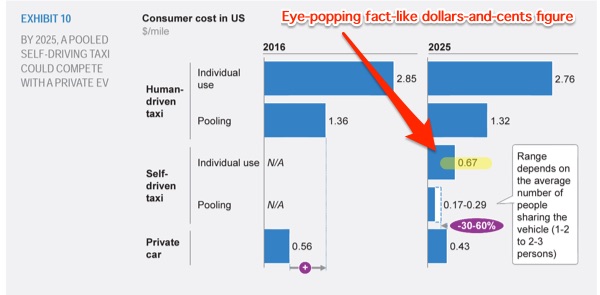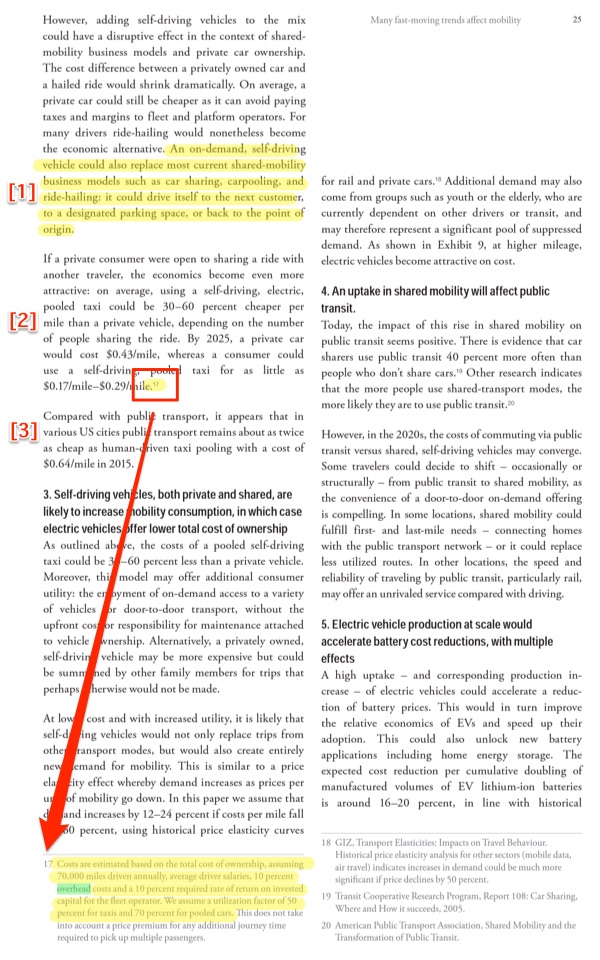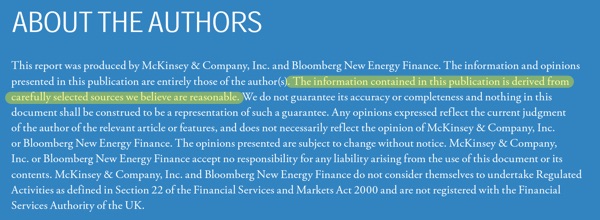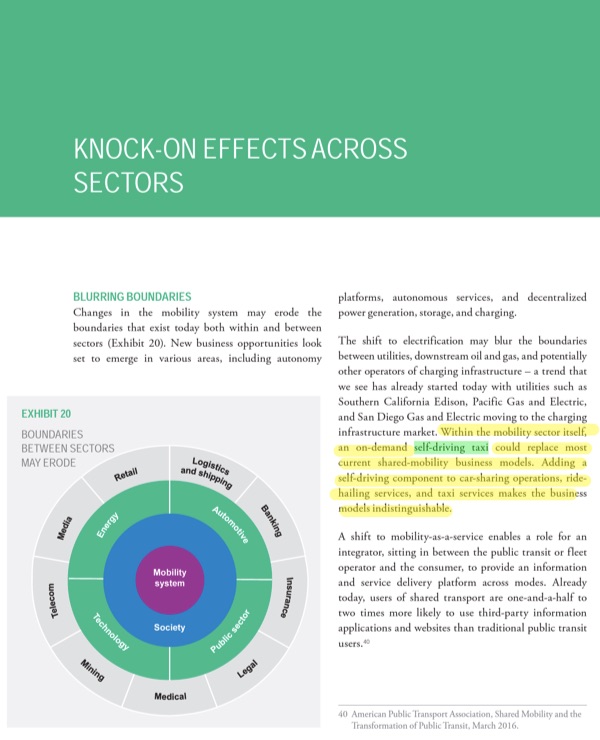By Lambert Strether of Corrente.
The FT’s Izabella Kaminska (“The autoignition temperature of manual cars is much higher than Fahrenheit 451“) brings McKinsey’s report on self-driving cars to our attention (“An Integrated Perspective on the Future of Mobility,” PDF). Bloomberg, writing on the report, put the key fact-like price comparison in the deck:
Autonomous taxis one-quarter the price of New York cab ride
And then quoted the following eye-popping fact-like dollars-and-cents figure:
The self-driving vehicles being pioneered by Tesla Motors Inc., Alphabet Inc.’s Google and others are poised to dramatically lower the cost of taxis, potentially making them cheaper than buses or subways, according to a joint report by Bloomberg New Energy Finance and McKinsey & Co. Having no driver to pay could reduce taxi prices to 67 cents a mile by 2025, less than a quarter of the cost in Manhattan today, the report found.
(The word “could” seems to be doing rather a lot of work in the second sentence.) But how were those figures “found”? On what basis did McKinsey, the “the trusted advisor and counselor to many of the world’s most influential businesses and institutions”, come to its conclusions?
And here, readers, I went wrong. I thought I would try to understand the business ratios and income statements of today’s taxi industry (NAICS code 4853; income statement from Yellow Cab of Missoula, MT[1]) and use those as a baseline to evaluate McKinsey’s analysis. That was a time-consuming mistake, and here is why.
Let’s look at the report, starting by having searched the PDF on “67.” Here is the source for Bloomberg’s quote, Exhibit 10:

I’ve helpfully highlighted the “67”; interestingly, a PDF search reveals that this is the only place where “67” appears. There is, for example, no table or equation showing the calculations through which McKinsey arrived at that figure.[2] Nevertheless, we look for some explanation, and the best I can find is in the text adjacent to Exhibit 10, on pages 23 and 25. (I’ve pasted a snippet from page 23 in at the top of page 25, and helpfully highlighted some of the text, and footnote 17):

Now, the $0.67 figure in Exhibit 10 applies only to the case of an “individual use” self-driving taxi (the chart says “self-driven,” but the caption is correct). That is, Jane Coder calls up a self-driving taxi to get to work, and when she’s done with her commute, the freed-up taxi responds to a call from Joe Coder to go home, and so on. The taxi is not shared. This use case is described in the paragraph marked “[1]”. Here is that paragraph:
For many drivers ride-hailing would nonetheless become the economic alternative. An on-demand, self-driving vehicle could also replace most current shared-mobility business models such as car sharing, carpooling, and ride-hailing: it could drive itself to the next customer, to a designated parking space, or back to the point of origin.
Do you see any calculations there — indeed, any numbers at all — that would justify the $0.67 figure? No? (Notice also that “could” and “would” are working hard in this paragraph, too.)
We move on to the paragraph marked [2]:
If a private consumer were open to sharing a ride with another traveler, the economics become even more attractive: on average, using a self-driving, electric, pooled taxi could be 30–60 percent cheaper per mile than a private vehicle, depending on the number of people sharing the ride. By 2025, a private car would cost $0.43/mile, whereas a consumer could use a self-driving, pooled taxi for as little as $0.17/mile–$0.29/mile17.
Here at least we see claims with numbers in them, but none of them are relevant to the “individual use self-driving taxi” case, and so the $0.67 figure remains a mystery, as yet unexplained. We move on to the paragraph marked [3]:
Compared with public transport, it appears that in various US cities public transport remains about as twice as cheap as human-driven taxi pooling with a cost of $0.64/mile in 2015.
The same applies; the $0.67 figure remains inexplicable. But wait! There’s that footnote 17 in the paragraph marked “[2]”:
Costs are estimated based on the total cost of ownership, assuming 70,000 miles driven annually[3], average driver salaries, 10 percent overhead costs and a 10 percent required rate of return on invested capital for the fleet operator. We assume a utilization factor of 50 percent for taxis and 70 percent for pooled cars. This does not take into account a price premium for any additional journey time required to pick up multiple passengers.
(I’ve helpfully underlined the weasel words, along with words that make me ask “How do you know that?”) Do you see a source for any of this? No? Why would that be? (Contrast footnote 17, in the left column, to footnotes 18, 19, and 20 in the right column, all of which provide sources.
Wishing to give McKinsey the benefit of the doubt, I looked for their editorial policies, which I found on page 64, on the About page. In relevant part:

So this really is the best part, isn’t it?
The information contained in this publication is derived from carefully selected sources we believe are reasonable.
Well, I should hope so! (“Trusted advisor and counsellor,” et cetera et cetera.) So that’s alright then! Although one could wish that the “reasonable” and “carefully selected” sources were named.[4]
So, I’ve managed to emulate the classic bad New Yorker article; I followed the ornithologists into the swamp, because when they said they heard the call of a rare bird, I believed them. But they didn’t find the bird! So, we still don’t know where McKinsey got its sixty-seven cents ($0.67) a mile figure for its “self-driving taxi” use case. (What the Bloomberg reporter thought they were doing when they repeated it is another question.) And we don’t know know why its “report” didn’t provide an explanation for it. Explanations that occur to me:
1. An editorial disaster. Nobody checked footnote 17 to add the sourcing for sixty-seven cents ($0.67) a mile figure. This strikes me as unlikely, given the level of attention given to the report’s design.
2. A public relations scam. McKinsey simply made up the sixty-seven cents ($0.67) a mile figure out of whole cloth. This strikes me as unlikely, given the whole “trusted advisor” schtick.
3. A bait and switch. The source of the calculations for sixty-seven cents ($0.67) a mile figure is internal and proprietary, and McKinsey won’t reveal anything until you engage them. This strikes me as unlikely, dittoez.
‘Tis a puzzlement!
NOTES
[1] I don’t want to whinge about this, but when I was a sprat, twenty years ago, and I wanted industry ratios and company reports, I’d go down to the Boston Public Library’s Business Branch, display my library card, and get the information for free. Google was awfully good at displaying results from “industry research” firms that demand a fee, but not so good with, er, “free stuff.” Am I looking for stats in all the wrong places?
[2] Why 67? Why not 65? Or 70? I’d hate to think McKinsey guilty of spurious precision.
[3] New York’s Taxicab Factbook estimates that the average cab travels 70,000 miles per year.
[4] There’s also “We do not guarantee its accuracy or completeness and nothing in this document shall be construed to be a representation of such a guarantee,” but I assume Bud from Legal insisted that go in, and I don’t hold it against them.
APPENDIX
I like this too. From page 49:

And the text:
Within the mobility sector itself, an on-demand self-driving taxi could replace most current shared-mobility business models. Adding a self-driving component to car-sharing operations, ridehailing services, and taxi services makes the business models indistinguishable.
Indeed it “could”! Exactly in the way the wizards of Unseen University nailing magic broomsticks under Sam Vimes’s horse-drawn coach made it “indistinguishable” from an airborne, supersonic vehicle!


I don’t get the appeal of a self-driving taxi. But I also avoid those self checkout counters at stores. I also don’t understand the somewhat breathless worship of Elon Musk.
The whole thing just strikes me as some sort of 12 year old’s fantasy of future-world at the price of the rest of humanity.
The vast majority of Silicon Valley companies, it was once explained to me, perform tasks that were once done for the founders by their mothers.
And then there is maintenance of the fleet. No way the average taxi garage is going to have two or three mechanics on duty, not if they check each car on a realistically regular schedule for service and safety of the sensors.
They will need more techs and better educated (more expensive) techs in order to be able to maintain the electronics of each system. So now, instead of drivers coming back to base and explaining/showing maintenance issues, equipment and multiple electronics/mechanically trained techs will be necessary, driving costs up.
A typical CNC machinery tech today probably makes near $100K today and carries $5K to $10K worth of potentially necessary test equipment into a call.. What are the odds of a traditional taxi company quickly swinging into this cultural, and expensive, mode of doing business?
And if they don’t do it right, insurance costs will go through the roof.
Insurance costs would NOT go through the roof, given how the Kleptocracy gets to fudge “liability rules” like with the nuclear-power industry and pipeline and of course the whole military-industrial-complex thing… Would be a great Public(ly funded risk eating reward gifting) Utility!
They will self insure as is done with workmans comp or create a captive and put money in a jar for the lawyers to fight the estates…
oops…
handle insurance claims.
Agreed, that is the catch with complex technology. It often requires more energy to develop and maintain then something less complex. Take away cheap energy, labor, etc. and the costs skyrocket.
robots will replace mechanics
Thanks much for this post.
Footnote 17 is a heck of a can opener. ha!
I think they picked NYC cab drivers so people would be less concerned about getting into a self driving car that may start crazily driving around honking it’s horn all the time. Then you’ll get to choose your language interface too, say, Yoda, Darth Vader or Latka.
As far as costs, the IRS allowance for you driving your car is 54c. But they are notorious skinflints and city cab driving is not known for optimal gas mileage.
And what happened to the pie charts??? The whole pie being cost of a cab ride, then the pie slices being vehicle costs, cab driver pay, and the third slice being ObamaCare? Footnote stating are vehicle cost based on high volume manufacturing, or some sort of specialty vehicle?
But anyway, I’ll believe it when I see it.
How do they project a lower cost per mile than the IRS? Crazyboy has a good question here.
They are saying 67 cents/mile, the IRS is 54 cents/mile. The IRS is known to understate it. Kiplinger does annual studies on it for biz who want to more accurately compensate employees. I don’t know the Kiplinger number lately, but in the past it was always substantially higher than the IRS number.
Plus, the whole insurance question is up in the air.
How much higher?
IIRC about 25%.
$2.00/mi fuel surcharge
$1.00/mi for inside accomodations
I’m having great difficulty reconciling any relationship between NYC Rate #01 and this pie-in-the-sky, flat $0.67/mi:
Johnny Cab : ” The fare is 18 credits please ….”
Doug Quaid : ” So sue me ! ”
Johnny Cab : ” AHHHHHHHH !!! “
Why not put in light rail street cars lines that can move great volumes of people like in oh.. the turn of the last Century?
https://en.m.wikipedia.org/wiki/List_of_streetcar_lines_in_Manhattan
Of couse their are the ignorant “journalists” like this asshat that have no clue why crappy, low efficiency stinky buses supplanted electric street cars
http://www.theverge.com/2016/2/4/10917320/nyc-streetcar-brooklyn-queens-deblasio-2020
New York City is about to shell out $2.5 billion for fancy electric streetcars
So it’s an uphill battle and thats just getting the project started, if approved the parasitic load will be the next challenge.
That’s not considered ‘progress’ apparently …….
Because light rail is simple, rugged, and proven (and not “innovative”).
get back to me when they offer self flying cars.
Uber is working on it. Seriously.
I’m thinking maybe the self driving cars need a solid track record (say five years) in normal operating conditions (rain, snow, fog, pedestrian traffic, etc.). Then we can talk about the true costs. Another problem, more technology can mean better efficiency but that is often WRT time (with the end-user) not energy which lends itself to approximating true cost far more than time in my opinion. More gizmos mean more manufacturing, means more labor, means more energy, means more displaced time on the production side, ironically.
Light rail. as in “cannot maneuver around double-parked cars” an electric overhead bus would possibly work, if you ignore the electric overheads. A city passenger bus designed to carry passengers and no luggage, not a diverted intercity bus, might be of interest..some places have these.
Couldn’t we just shove the double-parked car out of the way?
Yeah, double parked cars…light rail cant be done…. oh wait!
http://www.urbanrail.net/eu/at/vienna/tram/wien-tram.htm
Gosh! I guess ppl can learn pretty quick when they have to throw their cars plastic rear bumper and the airbag in the trunk before driving home from the car impound to write a check for the ticket they found on the windshield!
Go figure
How will the self-driving taxis get cleaned? (Here I’m reminded of entering a modern pissoir in Paris, not one of the old ones, and discovering a syringe, complete with blood spray. I suppose McKinsey would call that Excretion as a Service, and there might be more similarities between the pay toilet industry and the self-driving taxi industry than we think. )
More concretely, suppose you replace 10 human-driven cabs in a college town with 8 self-driving cars (because efficiency). It’s Friday night, and a student, as students will do, throws up in their cab. A human driver could stop and hose the cab out. What does the self-driving car do? Does a sensor kick in, and send it back to home base for cleaning? Now capacity is 7 (versus 10 before). Or does the next passenger open the door to encounter body fluids? In the first case, what happens to capacity and do McKinsey’s calculations take that into account? In the second, that’s not going to help with marketing. At all.
From the larger perspective, nobody seems to have given a lot of thought to what people will do
in these small confined spaces when they’re bored out of their skullswhen not driving. Lots of those things involve breakage and mess (accidental or on purpose). In the self-driving individual taxi use case, the cab interior is public space in the way that an interior shared with a human drive is not. And profit-making entities do not have a good record at managing public space.I’d guess that they’ll end up having a webcam and screen where a customer service human (eventually to be outsourced to Bangladesh) will greet you and bill you before unlocking the doors. They’ll also check if you’ve damaged the cab before unlocking the doors. A little like the folk they have standing vigil over the self service checkouts around here.
Of course this assumes that they actually manage to automate the driving bit.
Cutting margins by involving a human… And degrading the user experience as well. After all, one of the selling points of Uber is that when you arrive at your destination you don’t actually have to interact with an icky working class person to pay for your ride.
Where I am, a couple of call centres have located themselves near the university to get middle class sounding people who will work cheap (students). If Uber can’t do that for whatever reason, then I’m sure that the “Uber: Work from Home App” will be shortly forthcoming to harness (some) of their current workforce.
I say eventually outsourced to Bangladesh because I don’t think it will start there, but a system with perverse executive incentives tends toward counter productive decisions (I need to think of a snappier phrase for that).
Efficiency and progress is ours once more
Now that we have the Neutron bomb
It’s nice and quick and clean and gets things done
Away with excess enemy
But no less value to property
No sense in war but perfect sense at home
The sun beams down on a brand new day
No more welfare tax to pay
Unsightly slums gone up in flashing light
Jobless millions whisked away
At last we have more room to play
All systems go to kill the poor tonight
Gonna kill kill kill kill kill the poor
Kill kill kill kill kill the poor
Kill kill kill kill kill the poor tonight
Behold the sparkle of champagne
The crime rate’s gone, feel free again
Oh, life’s a breeze with you, Miss Lily White
Jane Fonda on the screen today
Convinced the liberals it’s okay
So let’s get dressed and dance away the night
While they kill kill kill kill kill the poor
Kill kill kill kill kill the poor
Kill kill kill kill kill the poor tonight
Kill kill kill kill kill the poor
Kill kill kill kill kill the poor
Kill kill kill kill kill the poor tonight
Behold the sparkle of champagne
The crime rate’s gone, feel free again
Oh, life’s a breeze with you, Miss Lily White
Jane Fonda on the screen today
Convinced the liberals it’s okay
So let’s get dressed and dance away the night
While they kill kill kill kill kill the poor
Kill kill kill kill kill the poor
Kill kill kill kill kill the poor tonight
Kill kill kill kill kill the poor
Kill kill kill kill kill the poor
Kill kill kill kill kill the poor tonight
Kill kill kill kill kill the poor
Kill kill kill kill kill the poor
Kill kill kill kill kill the poor tonight
Dead Kennedys
1970s economic disaster zone gave rise to them & all the other punk era bands – Pistols, Dammed, Clash, Iggy & the Stooges, Ramones, Richard Hell, Blondie.
2008′ economic disaster gave us the Justins – Bieber & Timberlake.
Just where oh where is there any sense of that the anger fuelling Trump’s rise is breaking through into the musical part pop culture.
Note I’m think primarily of “white” pop culture, what might be called “black” pop culture has always had the thread of (sometimes misplaced) anger running through it.
I was about to bring these points up. What if the homeless start sleeping in them? (Hopefully). These things are mobile dumpsters/shooting galleries/motels – now, that’s what I call innovation!
I think that autonomous vehicles are reasonably likely to be feasible and practical fairly soon, at least I’m more “optimistic” about the chances that a lot of people here. I would rather they not come into being though and would be quite happy of they failed miserably.
The cost per mile in this report seems ridiculous though. I figure that if they ever really do become common a lot of the income will come from exploiting the personal data that will be collected from the users. Of course we could make truly public transit a lot better, build the cities in such a way as to reduce the need for personal cars or make the autonomous cars, should they actually work a publicly owned non-profit service with strict privacy safeguards, but we all know how much pushback there would be against any of that from a lot of powerful entities.
> I think that autonomous vehicles are reasonably likely to be feasible and practical fairly soon
That’s not what the people with long experience doing the engineering think.
A corollary to the adage “Just because they make it in your size, doesn’t mean you should wear it !”
“Just because technology allows us to do some things, doesn’t mean we should do all those things!”
Human touch is important….
Long ago…
No one tore the ground with plowshares
or parceled out the land
or swept the sea with dipping oars —
the shore was the world’s end.
Clever human nature, victim of your inventions,
disastrously creative,
why cordon cities with towering walls?
Why arm for war?
– Ovid
I’ll believe in self driving cars replacing taxis when one can make it from Midtown Manhattan to JFK during rush hour in even double the time of a real cabby. I mean, you have to break every rule in the book, communicate with other drivers, stick your nose in gaps between cars that don’t exist…
I just don’t see how a self driving car can do this. Perhaps a car driven by a robot in the future with similar skills as a driving human, but until then…
as the resident ex-uber/lyft driver.
the junior analyst who did the math at McKinsey is high.